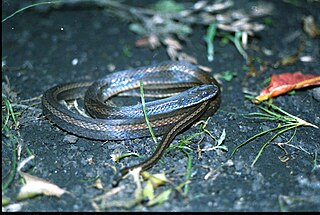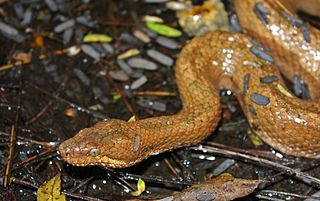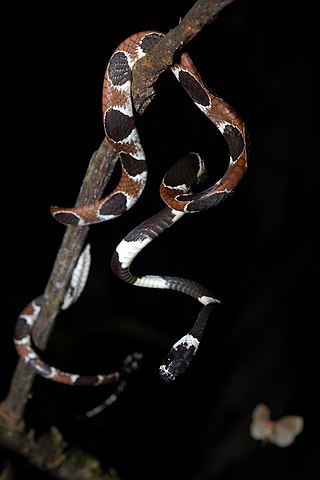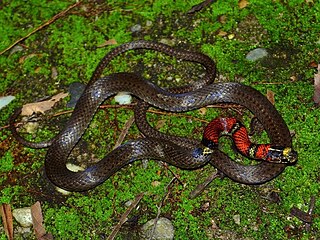
Ninia atrata, known commonly as Hallowell's coffee snake, Hallowell's earth snake, the red-nape snake, and the South American coffee snake, is a species of small terrestrial snake in the family Colubridae. The species is native to southern Central America and northern South America.

Tantilla is a large genus of harmless New World snakes in the family Colubridae. The genus includes 66 species, which are commonly known as centipede snakes, black-headed snakes, and flathead snakes.

Coniophanes is a genus of colubrid snakes, commonly referred to as black-striped snakes, but they also have many other common names. The genus consists of 17 species, and despite the common name, not all of them display striping.

Tropidophis, common name Caribbean dwarf boas, wood snakes or West Indian wood snakes, is a genus of dwarf boas endemic to the West Indies and South America. Currently, either 17 or 33 species are recognized, depending on the authority.

Porthidium lansbergii is a species of venomous snake, a pit viper in the family Viperidae. The species is native to eastern Central America and northwestern South America. Four subspecies are recognized, including the nominate subspecies described here.
Shaw's dark ground snake, also known commonly as Shaw's black-backed snake, and in Spanish as candelilla, guarda caminos, and reinita cazadora, is a species of snake in the family Colubridae. The species is native to northern South America.
The Santander blind snake is a species of snake in the family Leptotyphlopidae. The species is endemic to Colombia.

Catesby's snail-eater, also commonly known as Catesby's snail sucker, is a nocturnal species of nonvenomous snake in the family Colubridae. The species is native to northern South America.
Marco Antonio Serna Díaz was a Colombian herpetologist, ornithologist, and naturalist.

Xenopholis scalaris, Wucherer's ground snake, is a species of snake in the family Colubridae. The species is endemic to South America.

Rhinobothryum bovallii, commonly known as the coral mimic snake or the false tree coral, is a species of snake in the family Colubridae. The species is native to Central America and northwestern South America.

Synophis is a genus of snakes in the subfamily Dipsadinae of the family Colubridae. The genus is native to northwestern South America.

Mussurana bicolor, the two-colored mussurana, is a species of snake in the family Colubridae. The species is native to southern South America.

Synophis bicolor, known commonly as the bicolored shadow snake or the two-colored fishing snake, is a species of snake in the family Colubridae. The species is endemic to northwestern South America.

Synophis calamitus, the calamitous shadow snake, is a species of snake in the family Colubridae. The species is endemic to northwestern South America.

Synophis bogerti, known commonly as Bogert's fishing snake or Bogert's shadow snake, is a species of snake in the family Colubridae. The species is endemic to northwestern South America.

Scaphiodontophis annulatus, commonly known as the Guatemala neckband snake, is a species of snake in the family Colubridae. The species is native to southern Mexico, Central America, and Colombia. There are four recognized subspecies.
Atractus lasallei, also known commonly as Lasalle's ground snake, is a species of snake in the subfamily Dipsadinae of the family Colubridae. The species is endemic to Colombia.
Erythrolamprus guentheri, also known commonly as Günther's false coral snake, is a species of snake in the subfamily Dipsadinae of the family Colubridae. The species is native to Ecuador and Peru.
Synophis niceforomariae, also known as Nicéforo María's shadow snake, is a species of snake in the family, Colubridae. It is found in Colombia.














